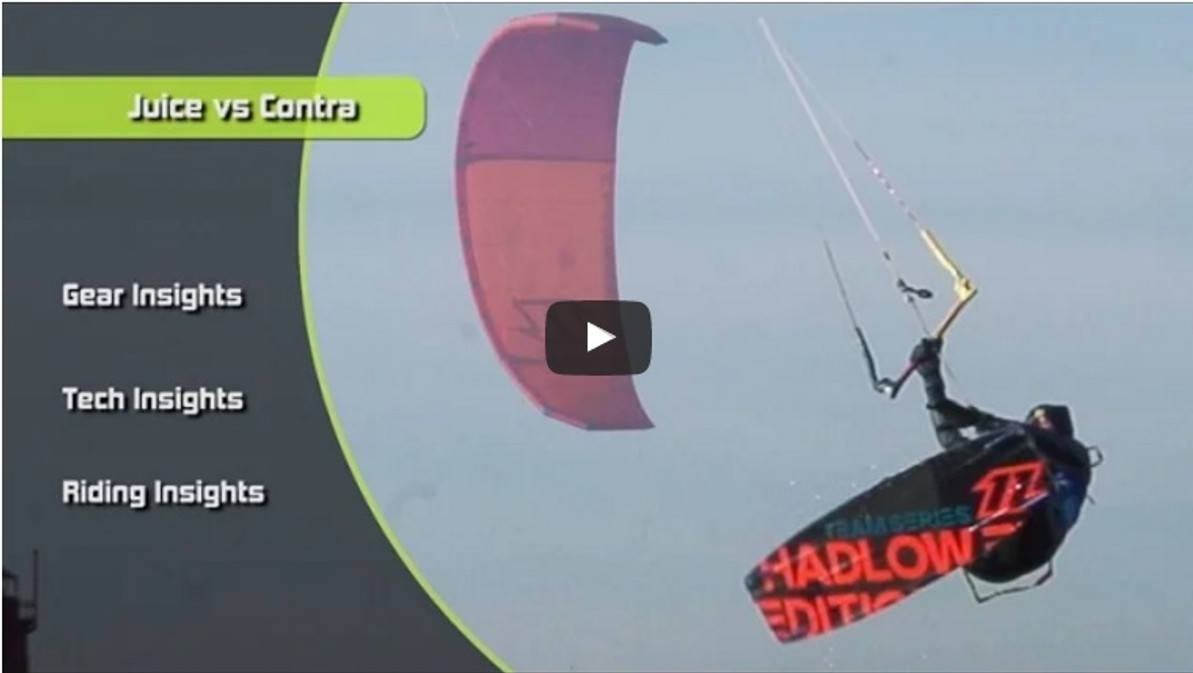Let's Chat: Cabrinha Contra vs. North Juice
Cabrinha Contra vs. North Juice
The last few years, light wind kites have seen some very real improvement. Gone are the days where companies simply take their 12 meter kites and blow them up to slow, clunky 17m or 18m kites.
All modern light wind kites are designed specifically for the demands of light wind and fly surprisingly nimbly and easily for their large size. North and Cabrinha have built a serious reputation over the years and established themselves as leaders of the industry.

Let's start with a brief objective side by side comparison:
- The Contra has heavy bar pressure, while the Juice has light pressure.
- The Contra is a 4 line, while the Juice can be flown as a 4 line or 5 line.
- Both kites are exclusively designed as light wind kites.
- The Contra is available in 13, 15, 17, & 19 meters. The Juice is available in 15 & 18 meters.
- The Contra has the Quickloop safety system that flags on one line, while the Juice has North’s traditional Iron Heart system with the option of a 5th line flag or the standard single line per a 4-line system.
The Contra has 3 bar offerings, including:
- The adjustable 1X Overdrive bar with recoil or trimlite depower options
- The fixed 1X bar with recoil or trimlite
Of course, all bars can be used with a traditional chicken loop or the revolutionary Fireball control system.
The Juice also has 3 bar offerings, including:
- The adjustable 5th Element 5-line control bar, famous for its light wind relaunch capabilities.
- The Trust 4-line control bar.
- The highly in-demand Click Bar

The Click Bar is North’s innovative new bar that uses a winder to trim the kite easily and efficiently, especially for riders with a shorter reach. On a side note, the Click Bar comes standard as a 4-line bar - this will work for the Juice. If you wish to fly the Juice as a 5-line with a Click Bar, you will need the 5th line upgrade.
Which kite fits your needs and riding preferences best?
There are six main categories to consider:
- Windrange
- Upwind ability
- Jumping
- All around performance
- Depower
- Safety Systems
Wind Range
As light wind kites, both the Contra and Juice have large wind ranges.
Wind range for light wind kites will determine how powered you’ll be in sub-par wind conditions and how much wind your kite can handle on the top end; it makes a huge difference when learning or riding in gusty conditions.A large wind range adds priceless extra days on the water to your kiting capabilities.
We find the Contra to have a slightly larger wind range on the high end, meaning you are less likely to have to change kites when the wind starts to build. Conversely, the Juice has slightly more low end, meaning you can get out in less wind.
Upwind Ability
Sick of walking back upwind? Make sure you’ve got enough power.
The great thing about these kites is they will do most of the work for the rider, making progression a breeze.
Between these two kites, it's a tie. It should be noted that the Contra does pull forward slightly more than the Juice. It’s important to consider that each brand offers different sizes. We are comparing the 15 to the 15, and the 17 to the 18. The 19 Contra is reserved for heavier riders above 200 pounds. With that in mind, don’t feel like you’re shorting yourself with the 18 Juice as opposed to the 19 Contra. The Juice has a little more low end power.
Jumping
- The Contra has a touch more hang time
- The Juice is more aggressive
- Fairly comparable between the two
All Around Performance
By all around performance we mean big airs, freestyle / wakestyle, surf and freeride. The Juice has a little more pound-for-pound power
The Contra turns a little slower and has more bar pressure
The Juice relaunches slightly easier.
Depower
Depower is a big deal with big kites - if the wind suddenly picks up on you, you don’t want to get blown right off of the water.
Cabrinha systems have a tendency to be able to dump more power than most other brands.
The Click Bar will assist in quicker depower for the Juice
Depower is more heavily determined by your control system than your kite
Safety Systems
The final point to chat about is the safety system.
Both kites are pretty comparable here as well. One thing to consider as well is there is a chance the 5th line could wrap around the kite. While this isn’t a big deal, it will require a self rescue to remedy.
Granted, if you’re deploying your safety, there is a good chance you were already initiating a self rescue.
Both kites will be great options in light wind conditions, there’s a reason these models have been around for so long. It’s up to you to decide what features and benefits are the most appealing.
Recent Posts
-
Code Foils 1250 R | Built for Glide, Momentum, and Flow
Tucker's been on a lot of different foils at this point, so it takes something pretty special to …20th May 2025 -
Ironman Athlete Learns to Wing Foil | Here's What He'd Do Differently
MACkite has a new addition to the crew and the winging team, but Skip is no stranger to wind spo …16th May 2025 -
How to Build Your Parawing Setup | One Wing or a Full Quiver?
Parawinging is really starting to take off, but it's still new territory in the foiling world an …9th May 2025







